Steel Construction System
Hekim Steel Construction System
Cross Section of Steel Construction System

Technical Specifications

Construction
Optional
- Partition Wall
- Office
- Mezzanine

Wall
Optional
- Painted galvanized corrugated steel sheet
- Hekim Sandwich Wall Panel with hidden screw

Roof
Optional
- Painted galvanized corrugated steel sheet
- Hekim Sandwich Roof Panel
- CTP (Light band)
- PVC / metal rain gutter and drain pipe

Insulation
Optional
- Hekim Sandwich Panel with hidden screw
- Hekim Sandwich Pithced Roof Panel

Doors
0,90 m x 2,00 m uninsulated steel sheet service door with cylinder lock.
Optional
- Insulated metal doors as requested
- Aluminium door
- PVC door
- Roll-up door
- Sectional door

Windows
Optional
- PVC window
- Aluminium window

Paint

Electricity Installation
Optional
- Lighting fixtures, switches, sockets, cables – cable channels, fuses – fusebox and circuit breaker. The installation is surface mounted.
- Telephone line
- Data line
- UPS
- TV
- Fire detection system
- Trifase electrical system

Sanitary Installation
Optional
- Sanitary materials
- Ventilation system
- Fire extinguishing system
- Heating and ventilation system
What Is A Steel Construction System?
A steel construction system refers to the structural framework of a building composed by primarily of steel components. It is designed to carry all loads acting upon the building, including dead loads, live loads, wind, and seismic forces. The popularity of this system stems from its exceptional strength-to-weight ratio, which allows for taller structures, wider spans, and greater design flexibility compared to concrete or timber-based frameworks.
Within this system, steel framing system construction is one of the most widely adopted approaches. It uses in prefabricated steel sections such as beams, columns, and trusses to create a skeleton that supports floors, walls, and roofs. This method ensures structural integrity while reducing on-site labor and construction time. In recent years, hybrid steel system in construction—combining steel with other materials like concrete or wood—has also gained traction, allowing engineers to balance cost, strength, and architectural aesthetics.
How Is A Steel Construction System Structured?
Structuring a steel construction system involves designing and assembling various steel components to create a stable and safe framework. The process starts with a architectural planning and structural analysis to determine the most effective arrangement of steel elements. Engineers consider factors such as load distribution, building height, span requirements, and environmental conditions to select appropriate materials and designs.
The primary elements of this system include vertical columns, horizontal beams, and diagonal bracing members, which are typically connected through welding or high-strength bolts. These elements form a rigid frame capable of resisting bending, torsion, and lateral forces. In steel framing system construction, secondary members such as purlins and girts are also added to support external cladding and roofing materials.
The hybrid steel system in construction may incorporate reinforced concrete cores for shear resistance, or timber panels for aesthetic finishes and insulation. This hybrid approach offers flexibility and can reduce costs in specific types of projects while maintaining structural performance. Ultimately, the structural configuration is tailored to meet the specific needs of the building, ensuring both safety and functionality.
Technical Specifications Of Steel Construction Systems
Technical specifications for steel construction systems are vital for ensuring durability, safety, and compliance with industry standards. These specifications cover everything from material properties to fabrication tolerances, assembly techniques, and load-bearing capacities. The most commonly used steel grades include ASTM A36, A992, and EN 10025 structural steels, selected based on their yield strength, ductility, and corrosion resistance.
Steel framing system construction typically employs hot-rolled or cold-formed steel profiles. Hot-rolled members are used in primary structural components due to their superior strength, while cold-formed steel is often applied in lightweight framing and non-load-bearing walls. Structural design follows standards such as Eurocode 3 or AISC codes, which govern aspects like lateral stability, buckling, and moment resistance.
Other important specifications include fire resistance ratings, thermal bridging solutions, and acoustic performance. Protective coatings like galvanization or intumescent paint are used to prevent corrosion and improve fire safety. Detailing is another crucial part of the technical process, especially in hybrid steel system in construction, where different materials intersect and must be integrated seamlessly. These specifications ensure that the system performs as intended under all operating conditions.
Benefits Of Using Steel Construction Systems
Steel construction systems offer a range of advantages that make them suitable for diverse construction projects. One of the most prominent benefits is strength. Steel’s high tensile and compressive capacity enables the creation of lightweight yet robust structures, which translates into taller buildings and larger spans with fewer supports. This feature opens up interior spaces and offers architectural freedom.
Another key advantage is speed. Since most steel components are prefabricated off-site, assembly times on-site are significantly reduced. This accelerates the overall project timeline and minimizes weather-related delays. The predictability of steel framing system construction improves scheduling and resource management.
Durability is another strong point. Steel is resistant to rot, mold, pests, and weather damage. It also offers excellent seismic performance due to its ductility and energy absorption capabilities. In hybrid steel system in construction, engineers can fine-tune the structural and thermal properties of a building by combining materials strategically, often enhancing sustainability and reducing life-cycle costs.
Furthermore, steel construction is environmentally friendly. Steel is 100% recyclable and can be reused multiple times without loss of quality. This contributes to LEED certification and other green building standards, making it a top choice in modern sustainable design.
How Is Steel Construction System Manufactured?
The manufacturing of a steel construction system begins with design and detailing, using Building Information Modeling (BIM) or Computer-Aided Design (CAD) to create accurate digital models. Once the design is finalized, fabrication occurs in a controlled factory environment. Steel sections are cut, drilled, welded, and assembled according to project specifications.
During fabrication, quality control checks are conducted to ensure that dimensions, welds, and finishes meet required standards. CNC machinery is commonly used for precision, especially in complex or repetitive tasks. Prefabrication allows for better control over material usage, minimizing waste and maximizing efficiency.
In hybrid steel system in construction, additional materials such as concrete elements or timber panels may be prefabricated in parallel, requiring careful coordination between suppliers. Once all components are ready, they are labeled and shipped to the site for installation. This integrated manufacturing process enhances consistency, safety, and overall quality.
How Is Steel Construction System Installed?
Installation of steel construction systems is a carefully planned operation that requires skilled labor and specialized equipment. The process begins with the preparation of foundations and anchor points, followed by the erection of primary steel frames. Cranes are often used to lift and position large beams and columns.
The components are then bolted or welded together, following the sequence defined in erection drawings. Temporary bracing may be used until the full frame is stabilized. In steel framing system construction, once the skeleton is complete, secondary elements like floor decking, wall framing, and roofing systems are added.
For hybrid steel system in construction, coordination is critical. Concrete cores might be cast on-site or prefabricated and integrated into the steel frame. Timber or composite panels are installed afterward, with attention to sealing, thermal continuity, and fire safety. Once all structural elements are in place, cladding, insulation, and interior finishes can be applied.
Applications Of Steel Construction Systems
Steel construction systems are used across a broad spectrum of building types due to their versatility and adaptability. In the commercial sector, they are the preferred choice for high-rise office towers, shopping malls, and logistics centers. Their ability to span long distances without interior supports makes them ideal for open-plan layouts and flexible floor designs.
In the residential sector, steel framing system construction is increasingly used in multi-family buildings, modular homes, and mixed-use developments. The speed and cleanliness of the process make it particularly suitable for urban environments. Schools, hospitals, and sports facilities also benefit from the strength and reliability of steel systems.
Hybrid steel system in construction is especially valuable in specialized applications such as bridges, cultural centers, and high-performance buildings. By combining materials strategically, designers can achieve unique aesthetic, acoustic, or thermal goals without compromising structural safety. Overall, the adaptability of steel construction makes it an excellent choice for nearly any architectural or engineering challenge.
Choosing The Right Steel Construction System For Your Project
Choosing the right steel construction system for your project involves analyzing multiple factors including budget, timeline, building function, and site constraints. A thorough needs assessment should be conducted in collaboration with architects, engineers, and contractors to define key requirements and limitations.
Steel framing system construction is best suited for projects that demand speed, scalability, and high structural integrity. It is cost-effective for standard commercial and residential developments. On the other hand, hybrid steel system in construction is recommended when specific performance goals need to be met—such as enhanced insulation, acoustic control, or architectural flexibility.
Material sourcing, fabrication capabilities, and construction logistics should also be evaluated. Selecting experienced suppliers and designers with a proven track record in steel construction will ensure smooth project execution and long-term value. Ultimately, aligning the system choice with your project’s unique goals and constraints will lead to better performance, reduced costs, and a more sustainable outcome.
